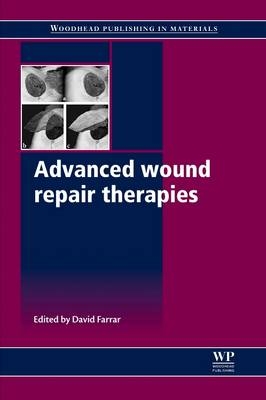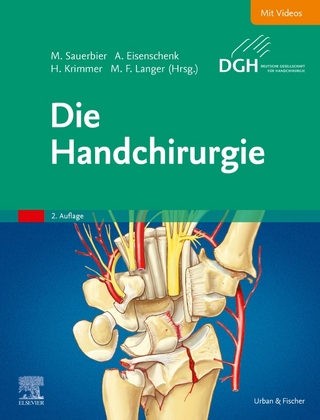
Advanced Wound Repair Therapies
Woodhead Publishing Ltd (Verlag)
978-0-08-101699-2 (ISBN)
- Titel wird leider nicht erscheinen
- Artikel merken
Part one provides an introduction to chronic wounds, with chapters covering dysfunctional wound healing, scarring and scarless wound healing and monitoring of wounds. Part two covers biomaterial therapies for chronic wounds, including chapters on functional requirements of wound repair biomaterials, polymeric materials for wound dressings and interfacial phenomena in wound healing. In part three, molecular therapies for chronic wounds are discussed, with chapters on topics such as drug delivery, molecular and gene therapies and antimicrobial dressings. Part four focuses on biologically-derived and cell-based therapies for chronic wounds, including engineered tissues, biologically-derived scaffolds and stem cell therapies for wound repair. Finally, part five covers physical stimulation therapies for chronic wounds, including electrical stimulation, negative pressure therapy and mechanical debriding devices.
With its distinguished editor and international team of contributors, Advanced wound repair therapies is an essential reference for researchers and materials scientists in the wound repair industry, as well as clinicians and those with an academic research interest in the subject.
David Farrar is Science Manager for Biomaterials at the Smith and Nephew Research Centre, York, UK
Contributor contact details
Introduction
Part I: Introduction to chronic wounds
Chapter 1: Dysfunctional wound healing in chronic wounds
Abstract:
1.1 Normal skin wound healing
1.2 Ageing skin and the onset of chronic, dysfunctional wound healing
1.3 Dysfunctional healing of chronic skin wounds
1.4 Conclusions
1.5 Acknowledgements
Chapter 2: The role of micro-organisms and biofilms in dysfunctional wound healing
Abstract:
2.1 Introduction
2.2 Microbiology and biofilms: not mutually exclusive
2.3 Biofilms and the interactive cooperative community
2.4 Biofilms in chronic wounds
2.5 Biofilms as therapeutic or restorative microbiology/modeling
2.6 Conclusion
Chapter 3: Scarring and scarless wound healing
Abstract:
3.1 Introduction
3.2 Wound healing process
3.3 Fibroproliferative scarring
3.4 Scarless fetal wound healing
3.5 Adult versus fetal wound healing
3.6 Treatment options for scars
3.7 Future trends
3.8 Conclusions
Chapter 4: The discovery and development of new therapeutic treatments for the improvement of scarring
Abstract:
4.1 Introduction
4.2 Scar-free and scar-forming healing
4.3 In vitro and in vivo models to investigate the mechanisms of scarring and evaluate potential treatments
4.4 Translation from pre-clinical studies to clinical efficacy
4.5 Understanding the mechanisms of action of prophylactic scar improvement therapies
4.6 Conclusions
Chapter 5: Monitoring chronic wounds and determining treatment
Abstract:
5.1 Introduction
5.2 Wound size measurements
5.3 Wound colour measurements
5.4 Background material
Part II: Biomaterial therapies for chronic wounds
Chapter 6: Functional requirements of wound repair biomaterials
Abstract:
6.1 Introduction
6.2 Wound pain and dressing materials
6.3 Exudate management
6.4 Prevention and control of infection
6.5 Odour management
6.6 Future trends
6.7 Sources of further information and advice
Chapter 7: Tissue-biomaterial interactions
Abstract:
7.1 Introduction: definitions
7.2 Overview of tissue-biomaterial interactions
7.3 Interactions at the biomaterial surface
7.4 Tissue response to biomaterial
7.5 Conclusion
Chapter 8: Polymeric materials for chronic wound and burn dressings
Abstract:
8.1 Introduction
8.2 Advanced moisture-retentive wound dressings
8.3 Polymeric materials in moist wound healing dressings
8.4 Infection control by polymeric wound dressings
8.5 Conclusion
8.6 Future trends
8.7 Acknowledgements
Chapter 9: Dry wound healing concept using spray-on dressings for chronic wounds
Abstract:
9.1 Introduction
9.2 The key properties of an ideal wound dressing
9.3 Using protein-based spray-on dressings in practice
9.4 Case studies
9.5 Conclusions
Chapter 10: Assessing the effectiveness of antimicrobial wound dressings in vitro
Abstract:
10.1 Introduction
10.2 Log reduction testing
10.3 Zone of inhibition (ZOI)
10.4 Bacterial barrier testing
10.5 Other considerations
10.6 Sources of further information and advice
Chapter 11: Adhesives and interfacial phenomena in wound healing
Abstract:
11.1 Principles of adhesion, adhesivity and interfacial behaviour
11.2 Bioadhesion: principles of adhesion applied to wound healing
11.3 Adhesives in wound healing: materials overview
11.4 Surgical adhesives and tissue sealants: structure and properties
11.5 Conclusions
Chapter 12: Wound healing studies and interfacial phenomena: use and relevance of the corneal model
Abstract:
12.1 Wound dressing biomaterials: interfacial aspects of compatibility and wound response
12.2 The corneal model in wound healing and biomaterial studies
12.3 Interfacial phenomena in ocular surface contact lens studies
12.4 Wound fluid and the tear film collection
12.5 Biomaterials in mucosal wound healing
12.6 Conclusions
Chapter 13: Sulphonated biomaterials as glycosaminoglycan mimics in wound healing
Abstract:
13.1 Introduction
13.2 Polymers and biomimesis
13.3 Biomimetic models
13.4 Sulphonated biomaterials in the context of biomimetic principles
13.5 Sulphonated biomaterials and the chronic wound: possible modes of biomimetic behaviour
13.6 Conclusions
Part III: Molecular therapies for chronic wounds
Chapter 14: Drug delivery dressings
Abstract:
14.1 Introduction
14.2 The role of drug delivery dressings in wound management
14.3 Topically delivered therapeutic compounds
14.4 Hydrocolloids
14.5 Hydrogels
14.6 Collagen
14.7 Alginates
14.8 Honey
14.9 Future trends
Chapter 15: Molecular and gene therapies for wound repair
Abstract:
15.1 Introduction
15.2 Methods of gene delivery
15.3 Gene therapy for wound healing
15.4 Ethical issues
15.5 Future trends
Chapter 16: Antimicrobial dressings
Abstract:
16.1 Introduction
16.2 Types of currently available dressings/formulations
16.3 Types of 'antimicrobials'
16.4 Future trends
Chapter 17: Avotermin: emerging evidence of efficacy for the improvement of scarring
Abstract:
17.1 There is a medical need for therapies that reduce scarring following surgery
17.2 Current treatments for scar management are unsatisfactory
17.3 New biological approaches are in development for the prophylactic improvement of scarring
17.4 Conclusions and future trends
Part IV: Biologically derived and cell-based therapies for chronic wounds
Chapter 18: Engineered tissues for wound repair
Abstract:
18.1 Introduction
18.2 The wound microenvironment in wound repair
18.3 Traditional approaches to wound repair
18.4 Development of cellular therapies
18.5 Development of acellular therapies
18.6 Conclusion
18.7 Acknowledgement
Chapter 19: Commercialization of engineered tissue products
Abstract:
19.1 Introduction
19.2 Engineered templates and scaffolds
19.3 Processed tissues
19.4 Cell-based products
19.5 Lessons from the first generation
19.6 The second generation of advanced therapies
19.7 Delivering value in advanced therapies
19.8 Advanced therapies in the marketplace
19.9 Conclusion
Chapter 20: Biologically derived scaffolds
Abstract:
20.1 Introduction
20.2 Polyhydroxyalkanoate (PHA)-derived scaffolds
20.3 Silk-derived scaffolds
20.4 Collagen-derived scaffolds
20.5 Elastin-derived scaffolds
20.6 Resilin-derived scaffolds
20.7 Keratin-derived scaffolds
20.8 Polysaccharide-derived scaffolds
20.9 Conclusions and future trends
Chapter 21: Stem cell therapies for wound repair
Abstract:
21.1 Introduction
21.2 Frequently utilized sources of adult stem cells
21.3 Clinical applications of stem cells to wound healing
21.4 Conclusions
21.5 Acknowledgement
21.7 Appendix: list of abbreviations
Part V: Physical stimulation therapies for chronic wounds
Chapter 22: Electrical stimulation for wound healing
Abstract:
22.1 Introduction
22.2 Current of injury
22.3 Physiological effects of electrical stimulation
22.4 Antibacterial effects of electrical stimulation
22.5 The effect of high voltage pulsed current (HVPC) on wound healing
22.6 The effect of low intensity direct currents (LIDC) on wound healing
22.7 Other types of electrical stimulation applied to wounds
22.8 Discussion
22.9 Conclusion
Chapter 23: Negative pressure wound therapy
Abstract:
23.1 Introduction
23.2 History of negative pressure wound therapy
23.3 The science of negative pressure
23.4 The pathophysiologic mechanisms of action of negative pressure
23.5 The search for the perfect negative pressure technology
23.6 Conclusions
23.7 Acknowledgement
Chapter 24: Debridement methods of non-viable tissue in wounds
Abstract:
24.1 Introduction
24.2 Background
24.3 Complications of non-viable tissue in wounds and the need for debridement
24.4 Presence of biofilm
24.5 Organisation of debridement
24.6 Timing and types of debridement
24.7 Scoring the effectiveness of debridement
24.8 Debridement in the diabetic foot
24.9 Conclusions
Index
| Erscheinungsdatum | 08.07.2016 |
|---|---|
| Reihe/Serie | Woodhead Publishing Series in Biomaterials |
| Verlagsort | Cambridge |
| Sprache | englisch |
| Themenwelt | Medizinische Fachgebiete ► Chirurgie ► Ästhetische und Plastische Chirurgie |
| Medizin / Pharmazie ► Medizinische Fachgebiete ► Notfallmedizin | |
| Medizin / Pharmazie ► Physiotherapie / Ergotherapie ► Orthopädie | |
| Technik ► Maschinenbau | |
| Technik ► Medizintechnik | |
| Technik ► Umwelttechnik / Biotechnologie | |
| ISBN-10 | 0-08-101699-9 / 0081016999 |
| ISBN-13 | 978-0-08-101699-2 / 9780081016992 |
| Zustand | Neuware |
| Haben Sie eine Frage zum Produkt? |
aus dem Bereich


